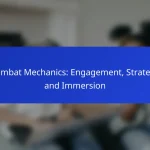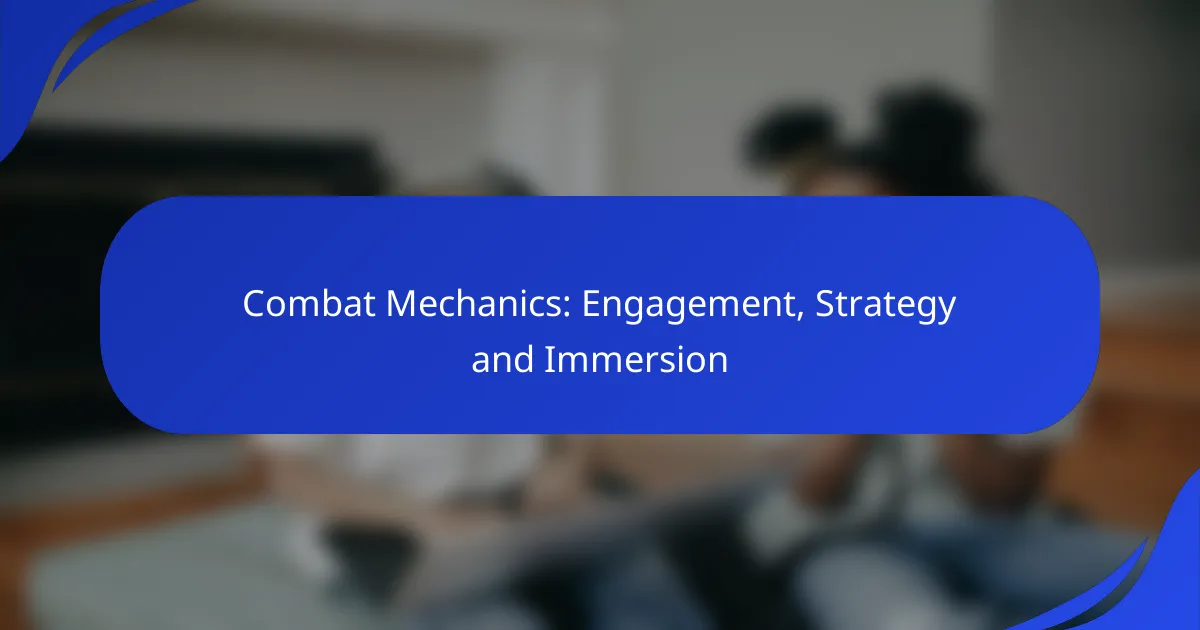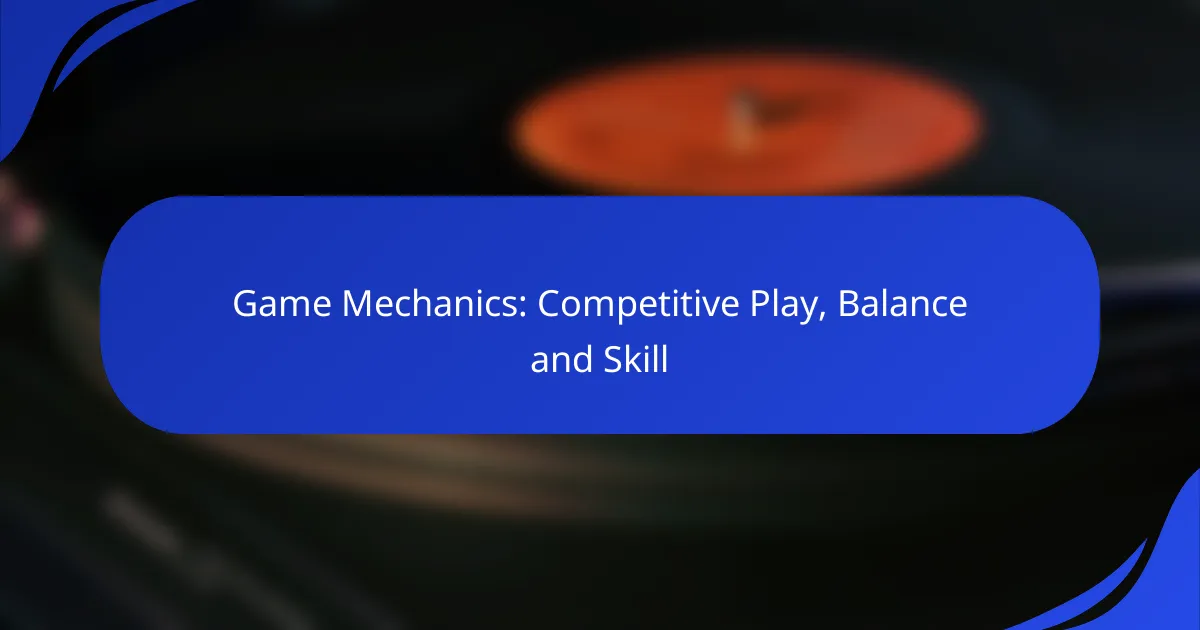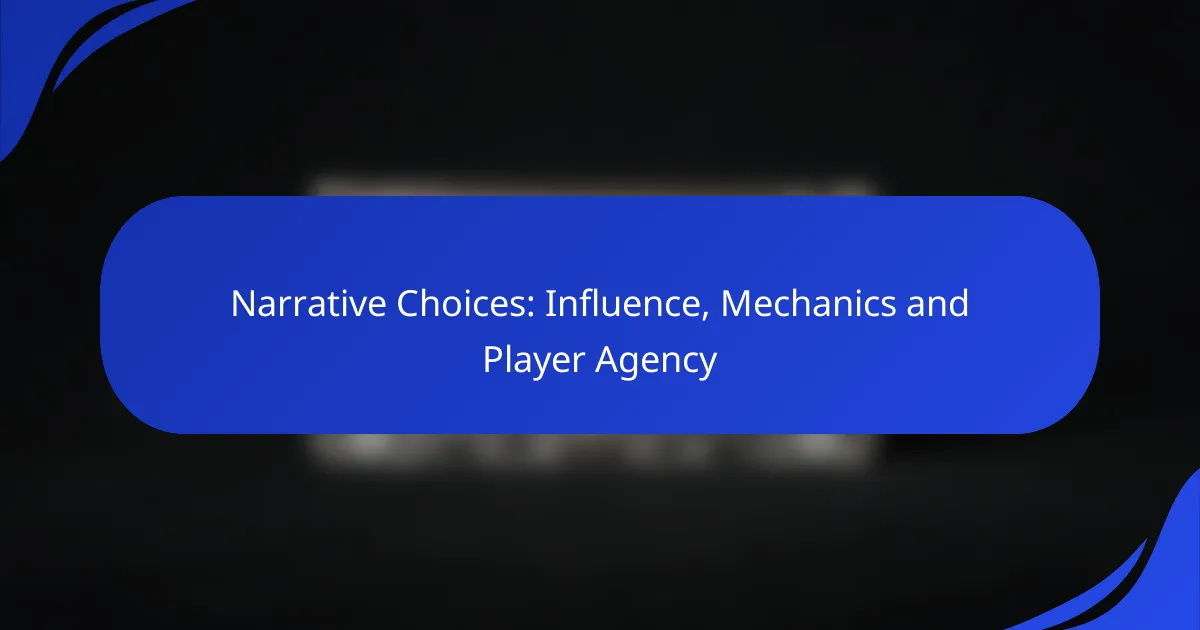Combat mechanics in video games are crucial for creating engaging and immersive experiences that captivate players. By integrating dynamic AI behavior, skill progression systems, and real-time feedback, developers can enhance player involvement. Additionally, effective strategies that focus on team dynamics and environmental factors can significantly improve performance in combat scenarios, fostering a deeper emotional connection and urgency during gameplay.
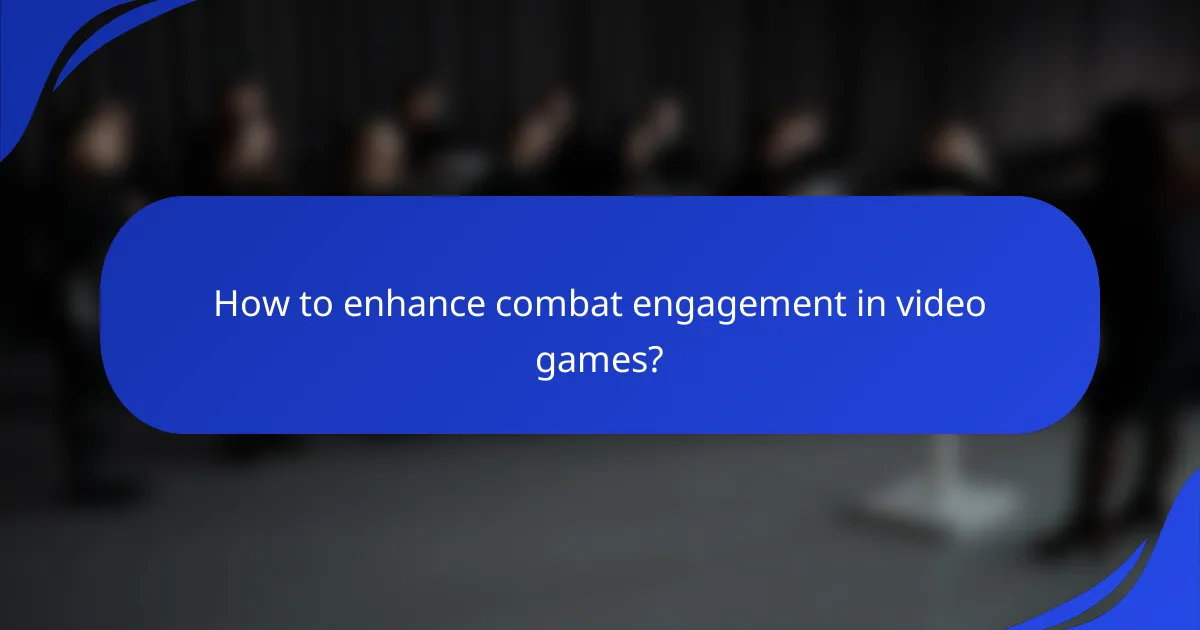
How to enhance combat engagement in video games?
Enhancing combat engagement in video games involves creating immersive experiences that keep players actively involved. Key strategies include implementing dynamic AI behavior, developing player skill progression systems, and utilizing real-time feedback mechanisms.
Dynamic AI behavior
Dynamic AI behavior refers to the ability of non-player characters (NPCs) to adapt and respond intelligently to player actions. This can create a more challenging and unpredictable combat environment, increasing player engagement. For example, AI that learns from player tactics can adjust its strategies, making encounters feel fresh and exciting.
To implement dynamic AI, consider using algorithms that allow NPCs to analyze player movements and decision-making patterns. This could involve varying attack patterns or retreating when outmatched. However, balance is crucial; overly aggressive AI can frustrate players, while too passive behavior may lead to boredom.
Player skill progression systems
Player skill progression systems are essential for enhancing engagement by rewarding players for their efforts and achievements. These systems can include leveling up, unlocking new abilities, or acquiring better gear, which keeps players motivated to improve their skills. For instance, a game might offer skill trees that allow players to specialize in certain combat styles.
When designing progression systems, ensure that the rewards are meaningful and that players feel a sense of accomplishment. Avoid making progression too fast, as this can diminish the satisfaction of earning new skills. Instead, aim for a balanced pace that encourages consistent play and mastery over time.
Real-time feedback mechanisms
Real-time feedback mechanisms provide players with immediate responses to their actions, enhancing the sense of immersion during combat. This can include visual cues, audio signals, or haptic feedback that indicate successful hits, damage taken, or special ability activation. Such feedback helps players adjust their strategies on the fly.
To implement effective feedback, consider using clear visual effects for critical hits or damage indicators that appear on-screen. Additionally, audio cues can enhance the experience by signaling important events, like a successful dodge or a missed attack. Ensure that the feedback is not overwhelming; it should enhance the experience without distracting from gameplay.

What strategies improve combat effectiveness?
Effective combat strategies enhance overall performance by optimizing team dynamics, resource allocation, and environmental advantages. By focusing on coordination, management, and terrain, teams can significantly increase their chances of success in engagements.
Team coordination tactics
Team coordination is essential for maximizing combat effectiveness. Clear communication, defined roles, and synchronized actions allow teams to respond swiftly and efficiently to changing situations. Regular drills and strategy sessions can help reinforce these elements.
Consider implementing a system of signals or codes to streamline communication during engagements. This can reduce confusion and ensure that all team members are on the same page, especially in high-pressure scenarios.
Resource management techniques
Effective resource management involves careful allocation of ammunition, health supplies, and equipment during combat. Teams should prioritize their resources based on the mission’s demands and the expected duration of engagement. Regular inventory checks can prevent shortages in critical moments.
Establishing a hierarchy for resource distribution can help teams make quick decisions. For example, prioritize distributing health packs to injured members first, while ensuring that ammunition is shared based on combat roles and needs.
Terrain advantage utilization
Utilizing terrain effectively can provide significant advantages in combat situations. Teams should familiarize themselves with the battlefield, identifying high ground, cover, and choke points that can be leveraged during engagements. Understanding the layout can inform strategic positioning and movement.
When planning, consider how different terrains affect visibility and mobility. For instance, dense forests may provide cover but limit sightlines, while open fields offer visibility at the cost of vulnerability. Adjust tactics accordingly to exploit these features to your advantage.

How does immersion affect combat mechanics?
Immersion significantly enhances combat mechanics by creating a more engaging and believable experience for players. When players feel fully absorbed in the game world, their emotional investment can lead to more strategic decision-making and a heightened sense of urgency during combat scenarios.
Environmental storytelling
Environmental storytelling involves using the game world to convey narratives and context without explicit dialogue. Elements like ruined buildings, scattered weapons, or signs of past battles can inform players about the history and stakes of the combat they are engaged in. This context can influence player strategies, as they may adapt their tactics based on the environment’s clues.
For instance, a player might choose to take cover behind a dilapidated wall that suggests a recent skirmish, enhancing their tactical positioning. Developers should consider how environmental details can guide players’ actions and decisions, making the combat feel more organic and connected to the game’s story.
Audio-visual integration
Audio-visual integration refers to the seamless combination of sound and visuals to create a cohesive combat experience. High-quality graphics and sound effects can heighten immersion, making players feel the impact of their actions. For example, the sound of gunfire combined with realistic animations can evoke a visceral response, enhancing the thrill of combat.
To maximize this integration, developers should ensure that audio cues match visual events closely. A well-timed explosion sound that coincides with a visual blast can reinforce the player’s sense of presence in the game world, making combat feel more intense and immediate.
Player agency and choice
Player agency and choice are crucial for immersion, as they empower players to make meaningful decisions that affect combat outcomes. When players have various strategies and tactics at their disposal, they are more likely to feel invested in the combat experience. Allowing players to choose their approach—whether stealth, brute force, or tactical maneuvers—can lead to a more personalized and engaging gameplay experience.
Developers should provide clear feedback on the consequences of player choices, reinforcing the impact of their decisions. For example, if a player opts for a stealthy approach, they should see the benefits of avoiding detection, while a direct assault might lead to intense firefights. Balancing these choices can enhance the overall immersion and satisfaction during combat encounters.

What are the best combat mechanics in popular games?
The best combat mechanics in popular games enhance player engagement and strategy, creating immersive experiences. Key examples include unique abilities, resource management, and reward systems that encourage tactical play.
Overwatch’s hero abilities
In Overwatch, each character possesses distinct abilities that define their role in combat. These abilities can range from offensive attacks to defensive shields and healing powers, allowing for diverse team strategies. Players must understand their hero’s strengths and weaknesses to maximize effectiveness in various scenarios.
For instance, a character like Reinhardt can shield teammates while charging into battle, creating opportunities for aggressive plays. Coordination with team members is crucial, as combining abilities can lead to powerful synergies that turn the tide of a match.
Dark Souls’ stamina management
Dark Souls emphasizes stamina management as a core combat mechanic, requiring players to balance attacking, dodging, and blocking. Each action consumes stamina, and running out can leave players vulnerable to enemy attacks. This mechanic encourages thoughtful decision-making and timing during encounters.
Players should aim to maintain a reserve of stamina for evasive maneuvers, especially during boss fights where patterns can be punishing. A common strategy is to attack two or three times and then retreat to regain stamina, ensuring readiness for the next move.
Call of Duty’s killstreak system
Call of Duty features a killstreak system that rewards players for achieving consecutive kills without dying. This mechanic incentivizes aggressive play and strategic positioning, as players can unlock powerful abilities or equipment after reaching specific kill counts. The rewards can significantly shift the momentum of a match.
For example, achieving a killstreak of three may grant a UAV for team visibility, while higher streaks can lead to airstrikes or powerful support. Players should balance risk and reward, as pushing for kills can expose them to enemy fire. Understanding the maps and enemy behavior is essential for maximizing killstreak potential.

What criteria should be considered when designing combat systems?
When designing combat systems, it is essential to consider player demographics, game genre specifications, and technical limitations. These criteria influence how engaging, strategic, and immersive the combat experience will be for players.
Player demographics
Understanding player demographics is crucial for tailoring combat systems to meet the preferences and skills of the target audience. Factors such as age, gaming experience, and cultural background can significantly affect how players engage with combat mechanics. For instance, younger players may prefer fast-paced action, while older players might enjoy more strategic, turn-based systems.
To effectively cater to different demographics, developers should conduct surveys or focus groups to gather insights on player preferences. This data can help in designing combat systems that resonate with the intended audience, enhancing overall enjoyment.
Game genre specifications
Each game genre has unique expectations regarding combat systems that developers must consider. For example, role-playing games (RPGs) often feature complex combat mechanics with character progression, while first-person shooters (FPS) prioritize quick reflexes and real-time action. Understanding these specifications helps create a combat system that feels authentic and satisfying within the genre.
Moreover, genre conventions can guide the balance between strategy and action. For instance, strategy games may require more tactical planning, while action games might focus on speed and agility. Aligning the combat system with genre expectations ensures a cohesive player experience.
Technical limitations
Technical limitations, such as hardware capabilities and software constraints, play a significant role in combat system design. Developers must consider the target platform’s processing power, memory, and graphical capabilities to ensure smooth gameplay. For example, mobile devices may require simplified combat mechanics compared to high-end gaming PCs.
Additionally, network latency can impact multiplayer combat experiences. Developers should optimize combat systems to minimize lag and ensure responsive controls. Testing across various devices can help identify performance issues and refine the combat experience for all players.
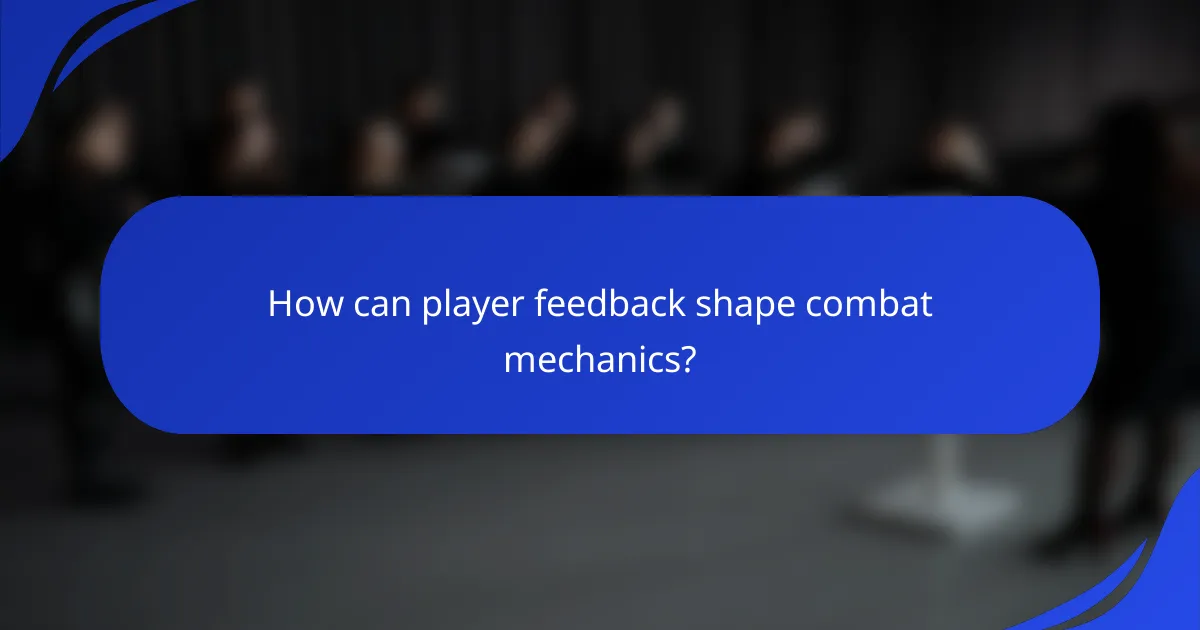
How can player feedback shape combat mechanics?
Player feedback is crucial in shaping combat mechanics by providing insights into user experiences and preferences. This input helps developers refine gameplay elements, ensuring they align with player expectations and enhance overall engagement.
Community-driven updates
Community-driven updates leverage player feedback to make meaningful changes in combat mechanics. Developers often monitor forums, social media, and in-game surveys to gather opinions and suggestions from the player base. This ongoing dialogue allows for the identification of common pain points and desired features.
For example, if players consistently report that a particular weapon feels ineffective, developers might adjust its damage output or reload speed based on this feedback. This iterative process not only improves gameplay but also fosters a sense of community ownership among players.
To effectively implement community-driven updates, developers should prioritize transparency and communication. Regularly sharing update plans and timelines can help manage player expectations and maintain engagement. Additionally, soliciting feedback on proposed changes can further refine updates before they go live.


